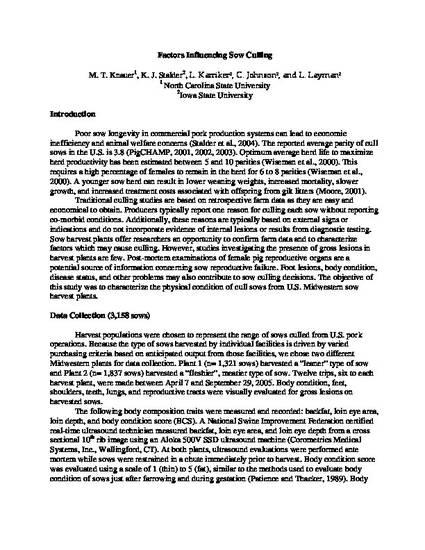
Poor sow longevity in commercial pork production systems can lead to economic inefficiency and animal welfare concerns (Stalder et al., 2004). The reported average parity of cull sows in the U.S. is 3.8 (PigCHAMP, 2001, 2002, 2003). Optimum average herd life to maximize herd productivity has been estimated between 5 and 10 parities (Wiseman et al., 2000). This requires a high percentage of females to remain in the herd for 6 to 8 parities (Wiseman et al., 2000). A younger sow herd can result in lower weaning weights, increased mortality, slower growth, and increased treatment costs associated with offspring from gilt litters (Moore, 2001). Traditional culling studies are based on retrospective farm data as they are easy and economical to obtain. Producers typically report one reason for culling each sow without reporting co-morbid conditions. Additionally, these reasons are typically based on external signs or indications and do not incorporate evidence of internal lesions or results from diagnostic testing. Sow harvest plants offer researchers an opportunity to confirm farm data and to characterize factors which may cause culling. However, studies investigating the presence of gross lesions in harvest plants are few. Post-mortem examinations of female pig reproductive organs are a potential source of information concerning sow reproductive failure. Foot lesions, body condition, disease status, and other problems may also contribute to sow culling decisions. The objective of this study was to characterize the physical condition of cull sows from U.S. Midwestern sow harvest plants.
Available at: http://works.bepress.com/kenneth_stalder/203/

This proceeding was published as M. T. Knauer, K. J. Stalder, L. Karriker, C. Johnson, and L. Layman. Evaluation of U.S. cull sows. Record of 31st Proc. National Swine Imprv. Fed. Conf. Ann. Mtg. Nashville, TN. Dec. 6-7, 2006. Posted with permission.